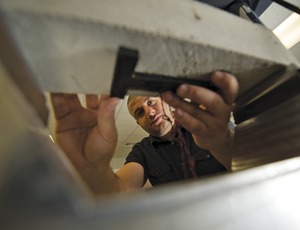
Researchers are testing novel infrastructure-monitoring sensors on roads. The new sensors are powered by passing vehicles.
The test could address a major flaw in sensors that are embedded to monitor degradation of infrastructure: They lose power, says Nizar Lajnef, assistant professor of civil and environment engineering at Michigan State University.
"Battery-powered sensors last only two to three years, max," says Lajnef. Moreover, it takes at least five years for a road and 10 to 12 years for most highways to show cracking, he adds. But because sensors are embedded in asphalt, batteries are not easily changed. The other option is to wire every sensor to a power source, a process that is too time consuming and expensive. "It's so hard to install classic, wired, straight-gate sensors that they've never been used in a real project," says Lajnef.
Lajnef and his team recently won two Federal Highway Administration contracts to test-drive their new technology. "It's called a piezo floating-gate sensor," says Lanjef. "It's a new electronic device that consumes less than a microwatt of power."
Lanjef claims it uses much less power than any commercial sensor—20 times less power than a battery-powered wristwatch.
The sensors keep energy consumption low by remaining off until stress or strain vibrations in the roadway wake them up. Once awake, sensors record data and then go back to sleep. Lajnef says, "It can record five to eight years of data continuously"—long enough to monitor infrastructure deterioration. Workers harvest data from the passive sensors by hitting them with radio frequencies, waking them long enough to deliver information.
"Then you have a map of all road strain and stress events," says Lajnef.
Researchers are using the data to predict how a bridge or highway ages and when it needs replacement. "You can detect damage under the road before it surfaces," he says.
Now, DOTs must visually monitor the aging of infrastructure for cracks. Lajnef says this retroactive method is more costly than predicting aging before it happens. "If you have the info that foretells cracking, you can anticipate it in terms of scheduling construction," says Lajnef.
He aims to have the price point of the 1-millimeter-sq sensor down to $1 apiece, comparable to wired sensors on the market. Lajnef says one FHWA contract funds research to deploy sensors by mixing them into concrete before pouring, so construction is uninterrupted.














Post a comment to this article
Report Abusive Comment